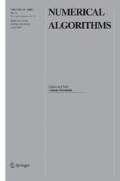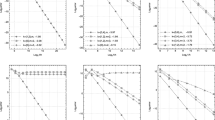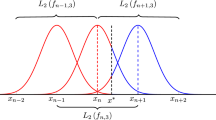Abstract
Runge–Kutta (RK) pairs furnish approximations of the solution of an initial value problem at discrete points in the interval of integration. Many techniques for enriching these methods with continuous approximations have been proposed. Here we construct C 1 continuous, eighth and ninth order interpolation methods for a recently appeared RK pair of orders 9(8). These interpolants share a very small leading truncation error making them suitable for use at quadruple precision, i.e. 32–33 decimal digits of accuracy. Extended numerical results justify our effort.
Similar content being viewed by others
References
Baker, T.S., Dormand, J.R., Gilmore, J.E., Prince, P.J.: Continuous approximation with embedded Runge–Kutta methods. Appl. Numer. Math. 22, 51–62 (1996)
Bogacki, P., Shampine, L.F.: Interpolating high-order Runge–Kutta formulas. Comput. Math. Appl. 20, 15–24 (1990)
Butcher, J.C.: Coefficients for the study of Runge–Kutta integration processes. J. Aust. Math. Soc. 3, 185–201 (1963)
Butcher, J.C.: Implicit Runge–Kutta processes. Math. Comput. 18, 50–64 (1964)
Butcher, J.C.: On Runge–Kutta processes of high order. J. Austral. Math. Soc. 4, 179–194 (1964)
Calvo, M., Montijano, J.I., Randez, L.: A fifth order interpolant for the Dormand and Prince Runge–Kutta method. J. Comput. Appl. Math. 29, 91–100 (1990)
Dormand, J.R., Prince, P.J.: Runge–Kutta triples. Comput. Math. Appl. 12, 1007–1017 (1986)
Dormand, J.R., Prince, P.J.: Runge–Kutta–Nystrom triples. Comput. Math. Appl. 13, 937–949 (1987)
Enright, W.H., Pryce, J.D.: Two Fortran packages for assessing initial value methods. ACM TOMS 13, 1–27 (1987)
Enright, W.H., Jackson, K.R., Norsett, S.P., Thomsen, P.G.: Interpolants for Runge–Kutta formulas. ACM TOMS 12, 193–218 (1986)
Famelis, I.Th., Papakostas, S.N., Tsitouras, Ch.: Symbolic derivation of Runge–Kutta order conditions. J. Symbolic Comput. 37, 311–327 (2004)
Gladwell, I.: Initial value routines in the NAG library. ACM TOMS 5, 386–400 (1979)
Gladwell, I., Shampine, L.F., Baca, L.S., Brankin, R.W.: Practical aspects of interpolation in Runge–Kutta codes. SIAM J. Sci. Statist. Comput. 8, 322–341 (1987)
Hull, T.E., Enright, W.H., Fellen, B.M., Sedgwick, A.E.: Comparing numerical methods of ordinary differential equations. SIAM J. Numer. Anal. 9, 603–637 (1972)
Horn, M.K.: Scaled Runge–Kutta algorithms for handling dense output. Rept. DFVLR-FB 81-13, Oberpfattenhonfen, FRG (1981)
Horn, M.K.: Fourth and fifth-order, scaled Runge–Kutta algorithms for treating dense output. SIAM J. Numer. Anal. 20, 558–568 (1983)
Owren, B., Zennaro, M.: Derivation of efficient continuous explicit Runge–Kutta methods. SIAM J. Sci. Statist. Comput. 13, 1488–1501 (1992)
Prince, P.J., Dormand, J.R.: High order embedded Runge–Kutta formulae. J. Comput. Appl. Math. 7, 67–75 (1981)
Shampine, L.F.: Interpolation for Runge–Kutta methods. SIAM J. Numer. Anal. 22, 1014–1027 (1985)
Sharp, P.W., Verner, J.H.: Generation of high-order interpolants for explicit Runge–Kutta pairs. ACM TOMS 24, 13–29 (1998)
Sweetser, T.H.: An end-to-end trajectory description of the LISA mission. Classical Quant. Grav. 22, S429–S435 (2005)
Tsitouras, Ch.: Optimized explicit Runge–Kutta pair of orders 9(8). Appl. Numer. Math. 38, 123–134 (2001)
Tsitouras, Ch., Papageorgiou, G.: Runge–Kutta interpolants based on values from two successive integration steps. Computing 43, 255–266 (1990)
Verner, J.H.: Differentiable interpolants for high-order Runge–Kutta methods. Report 1990-9, Dept of Mathematics and Statistics, Queen’s University, Ontario, Canada (1990)
Verner, J.H.: Differentiable interpolants for high-order Runge–Kutta methods. SIAM J. Numer. Anal. 30, 1446–1466 (1993)
Verner, J.H.: High-order explicit Runge–Kutta pairs with low stage order. Appl. Numer. Math. 22, 345–357 (1996)
Wolfram, S.: The Mathematica Book, 5th edn. Wolfram Med., Champaign, IL (2003)
Author information
Authors and Affiliations
Corresponding author
Rights and permissions
About this article
Cite this article
Tsitouras, C. Runge–Kutta interpolants for high precision computations. Numer Algor 44, 291–307 (2007). https://doi.org/10.1007/s11075-007-9104-4
Received:
Accepted:
Published:
Issue Date:
DOI: https://doi.org/10.1007/s11075-007-9104-4




